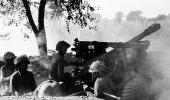'One of the bullets grazed General Sagat's hand and one injured Flying Officer Sidhu in the leg.'
'The helicopter was quickly flown back to Agartala and after landing they found that the aircraft had been peppered with 38 bullet holes!'
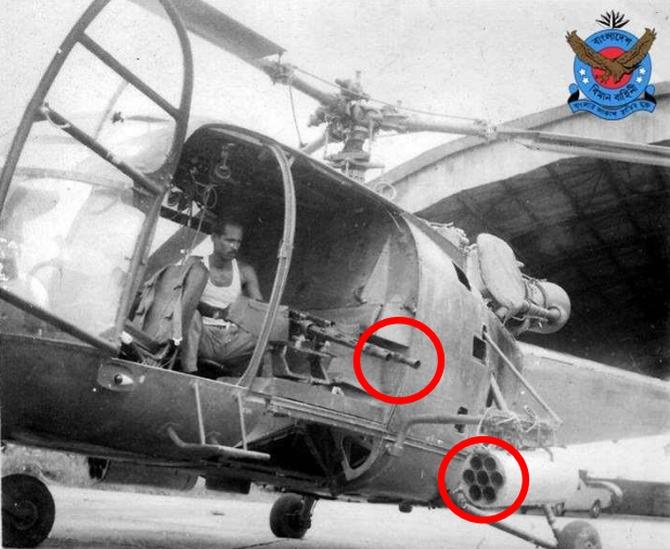
Air Commodore Ram Mohan Sridharan -- 'Doc' Sridharan, as he is popularly known in the Indian Air Force -- was commissioned as a helicopter pilot in the IAF in June 1969.
He was fully operational on the Mi-4 helicopter by the time the war started in December 1971 and flew a large number of missions as part of the 110 Helicopter Unit, then based at Kumbhigram (near Silchar in Assam).
Air Commodore Sridharan tells Air Commodore Nitin Sathe how IAF helicopters played a crucial role in the 1971 War.
The first operational missions into East Pakistan by the IAF was by the pilots of Kilo flight.
One Chetak helicopter was tasked to carry out a recce of probable landing sites in the general area of Sylhet.
The Ccommanding Officer and Flight Commander Group Captaiin Chandan Singh and Lieutenant General Sagat Singh went for the recce. The sortie was flown at low levels and several places identified.
While they were orbiting over the area, the Pakistanis realised that the aircraft was not their own and let go a volley of fire.
One of the bullets grazed General Sagat's hand and one injured Flying Officer G P S Sidhu in the leg. The helicopter was quickly flown back to Agartala and after landing they found that the aircraft had been peppered with 38 bullet holes!
"It had been a providential escape for all the five occupants of the aircraft as no bullet found its mark at any of its vital components!" recalls Air Commodore Sridharan.
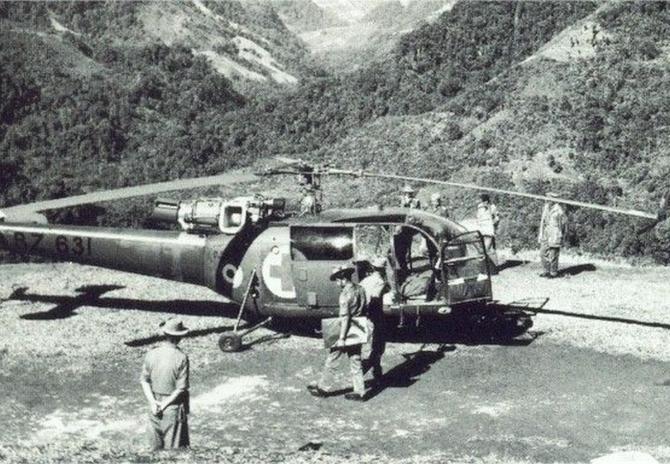
"After landing, all looked quite shaken, but General Sagat was cool as he always was."
"He instructed that the Chetak be checked for flight worthiness and asked for Sidhu to be evacuated to the hospital at Teliamura. Sidhu could not take part in the war thereafter as he recuperated in the hospital."
"The landing grounds had been selected during this eventful sortie and this episode made us all the more determined to press on with the task at hand."
The war plans of the unit required 8 aircraft to be positioned at the Corps HQ at Teliamura.
The rest of the serviceable machines were to be flown to different helipads in the corps zone -- 'dispersed' to remain safe from enemy air attacks.
Doc Sir was involved in ferrying the machines to these locations along with its ground crew and having completed this task, he was to join his team at Teliamura.
Doc Sir reached Teliamura on the afternoon of December 7 to be briefed for the missions now being undertaken to Sylhet by his unit from a small airfield at Kailashaher.
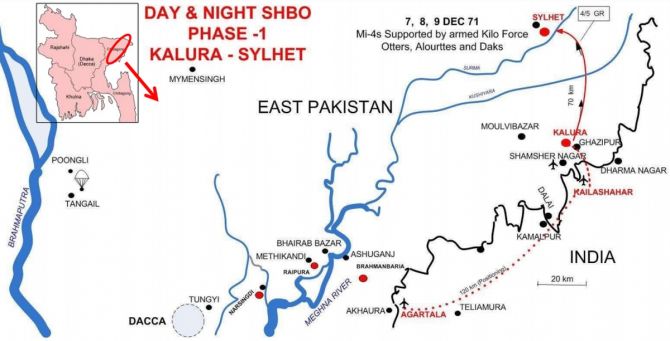
By the time he took off from Teliamura and landed at Kailashaher, the first mission to Syhlet had already taken off and was on its way back after dropping the troops of the 4/5 Gurkha regiment.
"I had to wait until 1000 hours the next day to do my first mission into East Pakistan," the IAF veteran recalls. Doc sir was detailed as the number 3 in a three aircraft formation which was to carry 36 troops, some mortars and ammunition to Syhlet.
Some enemy fire had been encountered during the first-day missions and the crew were therefore briefed that the offloading had to be fast and swift to minimise time on the ground.
The troops were also briefed about the same and practiced for it.
"The problem in my aircraft was that I was carrying heavy loads and it would take extra time on the ground to offload. The troops on board my helicopter assured me that they would be quick and I shouldn't worry," Air Commodore Sreedharan remembers.
"We landed at Sylhet and we were off the ground in a few minutes and on our way back to the safe confines of our base in the next 35 minutes. My first mission was over and it had been successful!"
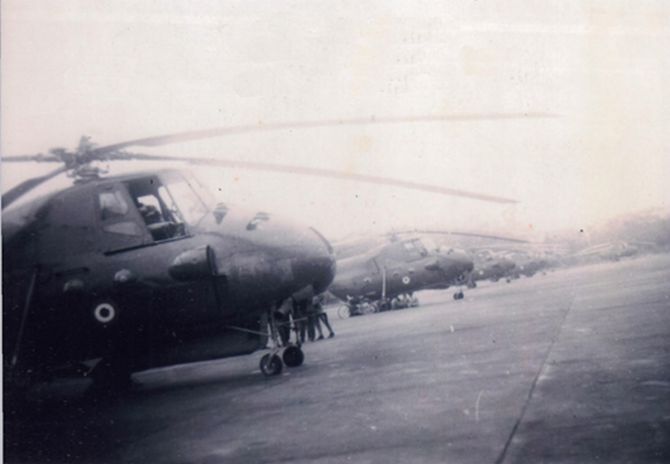
Doc sir flew 5 sorties on his first day at work in the war. Three by day and two by night. It was baptism by fire and he still remembers every moment spent on the missions.
The unit had been successful in putting across 4/5 Gurkhas into Sylhet in Phase 1 of the operations.
A total of 649 troops of the 4/5 Gurkhas was successfully inserted into Syhlet along with 13,000 kg of their load.
"These boys were so motivated and fired up to fight the enemy... as they jumped to the ground one could hear their war cry over the din of the running engines and rotors which, by no means, were silent!" recalls the veteran.
4/5 Gurkhas with support from other arms of the Indian Army demolished the resistance at the Pakistan army's Syhlet garrison in the next few days.
"On our way back, we had to get back some of the boys who had been injured. Bleeding and badly injured, they would still manage a smile and one could see that the fight hadn't gone out of them," the air commodore remembers.
"Almost all our aircraft got a few bullets holes and these were quickly repaired by our most efficient technical crew who ensured that the requisite number of machines were always available for ensuing missions."
Air Commodore Nitin Sathe retired from the Indian Air Force in February 2020 after a distinguished 35 year career.
The author of three books, you can read Air Commodore Nitin Sathe's earlier features here.
Feature Presentation: Rajesh Alva/Rediff.com



